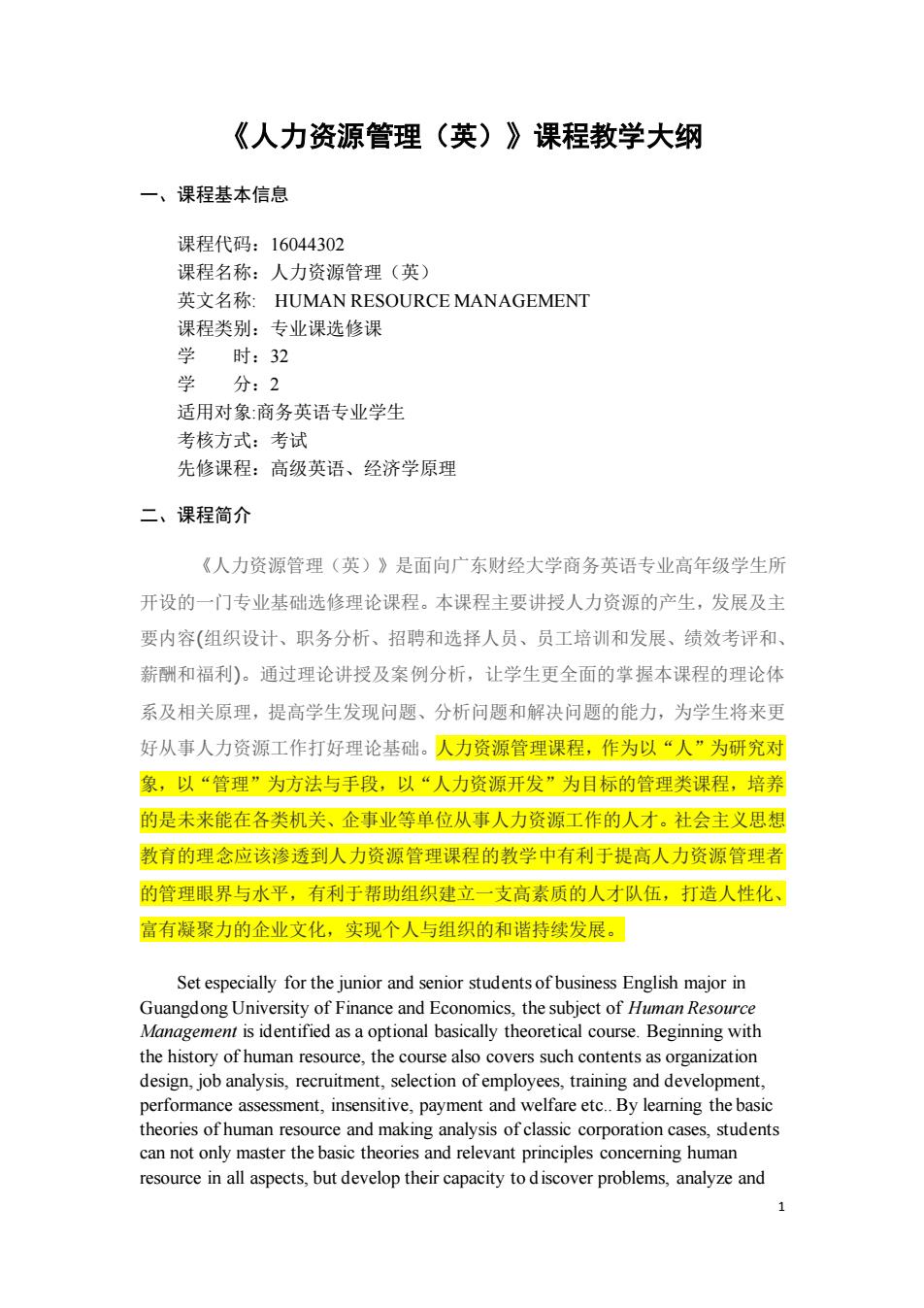
《人力资源管理(英)》课程教学大纲 一、课程基本信息 课程代码:16044302 课程名称:人力资源管理(英) 英文名称:HUMAN RESOURCE MANAGEMENT 课程类别:专业课选修课 学时:32 学 分:2 适用对象:商务英语专业学生 考核方式:考试 先修课程:高级英语、经济学原理 二、课程简介 《人力资源管理(英)》是面向广东财经大学商务英语专业高年级学生所 开设的一门专业基础选修理论课程。本课程主要讲授人力资源的产生,发展及主 要内容(组织设计、职务分析、招聘和选择人员、员工培训和发展、绩效考评和 薪酬和福利)。通过理论讲授及案例分析,让学生更全面的掌握本课程的理论体 系及相关原理,提高学生发现问题、分析问题和解决问题的能力,为学生将来更 好从事人力资源工作打好理论基础。人力资源管理课程,作为以“人”为研究对 象,以“管理”为方法与手段,以“人力资源开发”为目标的管理类课程,培养 的是未来能在各类机关、企事业等单位从事人力资源工作的人才。社会主义思想 教育的理念应该渗透到人力资源管理课程的教学中有利于提高人力资源管理者 的管理眼界与水平,有利于帮助组织建立一支高素质的人才队伍,打造人性化 富有凝聚力的企业文化,实现个人与组织的和谐持续发展。 Setespecially for the junior and senior studentsof business English major in Guangdong University of Finance and Economics,the subject of Human Resource Management is identified as a optional basically theoretical course.Beginning with the history of human resource,the course also covers such contents as organization design,job analysis,recruitment,selection of employees,training and development performance assessment,insen sitive,payment and elfare etc..By leaming the bas theories of human resource and making analysis of classic corporation cases,students can not only master the basic theories and relevant principles concerning human resource in all aspects,but develop their capacity to discover problems,analyze and
1 《人力资源管理(英)》课程教学大纲 一、课程基本信息 课程代码:16044302 课程名称:人力资源管理(英) 英文名称: HUMAN RESOURCE MANAGEMENT 课程类别:专业课选修课 学 时:32 学 分:2 适用对象:商务英语专业学生 考核方式:考试 先修课程:高级英语、经济学原理 二、课程简介 《人力资源管理(英)》是面向广东财经大学商务英语专业高年级学生所 开设的一门专业基础选修理论课程。本课程主要讲授人力资源的产生,发展及主 要内容(组织设计、职务分析、招聘和选择人员、员工培训和发展、绩效考评和、 薪酬和福利)。通过理论讲授及案例分析,让学生更全面的掌握本课程的理论体 系及相关原理,提高学生发现问题、分析问题和解决问题的能力,为学生将来更 好从事人力资源工作打好理论基础。人力资源管理课程,作为以“人”为研究对 象,以“管理”为方法与手段,以“人力资源开发”为目标的管理类课程,培养 的是未来能在各类机关、企事业等单位从事人力资源工作的人才。社会主义思想 教育的理念应该渗透到人力资源管理课程的教学中有利于提高人力资源管理者 的管理眼界与水平,有利于帮助组织建立一支高素质的人才队伍,打造人性化、 富有凝聚力的企业文化,实现个人与组织的和谐持续发展。 Set especially for the junior and senior students of business English major in Guangdong University of Finance and Economics, the subject of Human Resource Management is identified as a optional basically theoretical course. Beginning with the history of human resource, the course also covers such contents as organization design, job analysis, recruitment, selection of employees, training and development, performance assessment, insensitive, payment and welfare etc.. By learning the basic theories of human resource and making analysis of classic corporation cases, students can not only master the basic theories and relevant principles concerning human resource in all aspects, but develop their capacity to discover problems, analyze and
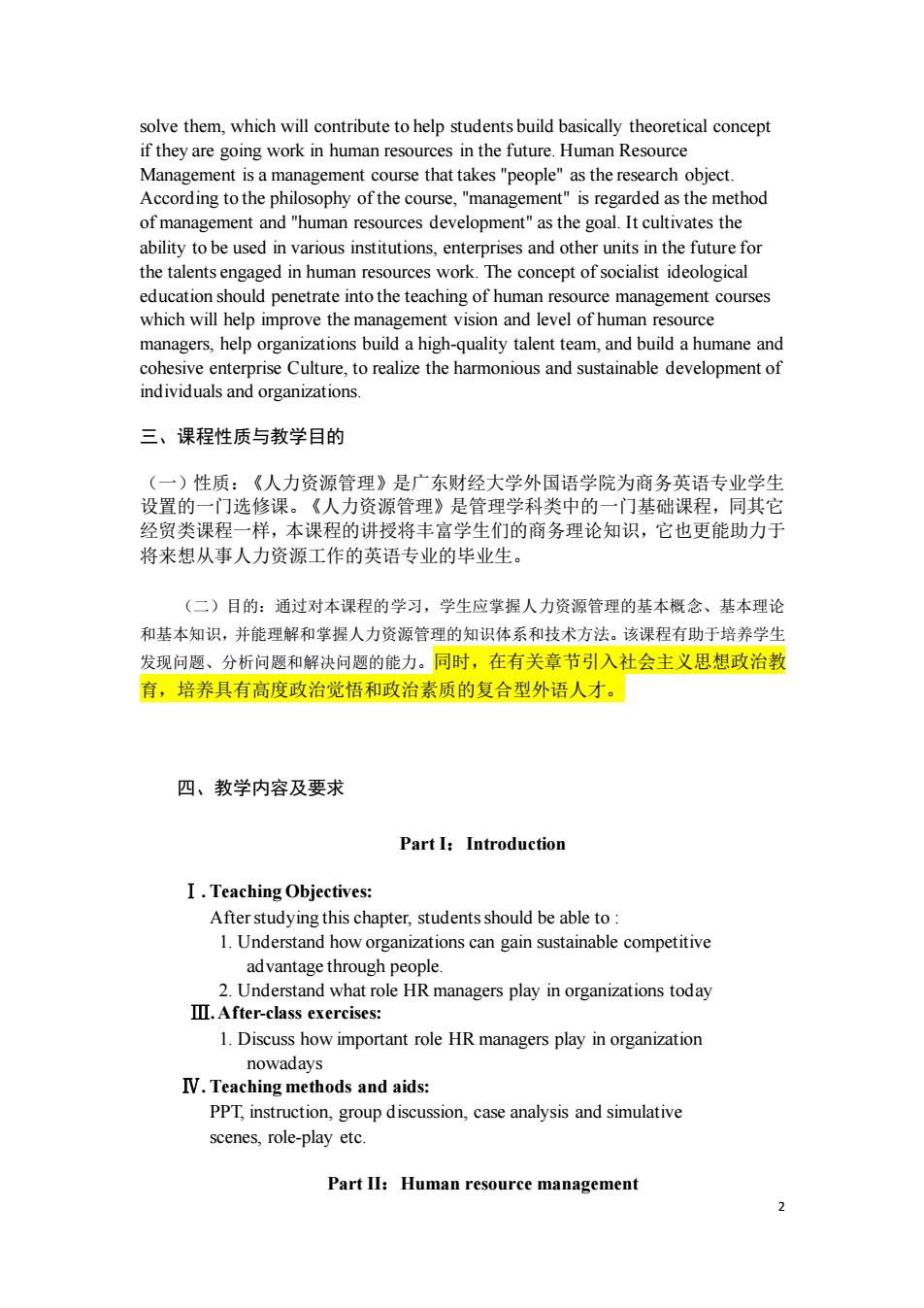
solve them,which will contribute to help students build basically theoretical concept if they are going work in human resources in the future.Human Resource Management is a management course that takes"people"as the research object. According to the philosophy of the course."management"is regarded as the method of management and"human resources development"as the goal.It cultivates the ability to be used in various institutions.enterprises and other units in the future for the talents engaged in human resources work.The concept of socialist deologica education should penetrate into the teaching of human resource management courses which will help improve the management vision and level of human resource managers,help organizations build a high-quality talent team,and build a humane and cohesive enterprise Culture.to realize the harmonious and sustainable development of individuals and organizations 三、课程性质与教学目的 (一)性质:《人力资源管理》是广东财经大学外国语学院为商务英语专业学生 设置的一 门选修课。《人力资源管理》是管理学科类中的 门基础课程 同其它 经贸类课程一样,本课程的讲授将丰富学生们的商务理论知识,它也更能助力于 将来想从事人力资源工作的英语专业的毕业生。 (二)目的:通过对本课程的学习,学生应掌握人力资源管理的基本概念、基本理论 和基本知识,并能理解和掌握人力资源管理的知识体系和技术方法。该课程有助于培养学生 发现问愿、分析问题和解决问题的能力。同时,在有关章节引入社会主义思想政治教 育,培养具有高度政治觉悟和政治素质的复合型外语人才。 四、教学内容及要求 Part I:Introduction I.Teaching Objectives: After studying this chapter,students should be able to 1.Understand how organizations can gain sustainable competitive ad vantage through people. 2.Understand what role HR managers play in organizations today I.After-class exercises: 1.Discuss how important role HR managers play in organizatior nowadays IV.Teaching methods and aids: PPT,instruction,group discussion,case analysis and simulative scenes,role-play ete Part II:Human resource management
2 solve them, which will contribute to help students build basically theoretical concept if they are going work in human resources in the future. Human Resource Management is a management course that takes "people" as the research object. According to the philosophy of the course, "management" is regarded as the method of management and "human resources development" as the goal. It cultivates the ability to be used in various institutions, enterprises and other units in the future for the talents engaged in human resources work. The concept of socialist ideological education should penetrate into the teaching of human resource management courses which will help improve the management vision and level of human resource managers, help organizations build a high-quality talent team, and build a humane and cohesive enterprise Culture, to realize the harmonious and sustainable development of individuals and organizations. 三、课程性质与教学目的 (一)性质:《人力资源管理》是广东财经大学外国语学院为商务英语专业学生 设置的一门选修课。《人力资源管理》是管理学科类中的一门基础课程,同其它 经贸类课程一样,本课程的讲授将丰富学生们的商务理论知识,它也更能助力于 将来想从事人力资源工作的英语专业的毕业生。 (二)目的:通过对本课程的学习,学生应掌握人力资源管理的基本概念、基本理论 和基本知识,并能理解和掌握人力资源管理的知识体系和技术方法。该课程有助于培养学生 发现问题、分析问题和解决问题的能力。同时,在有关章节引入社会主义思想政治教 育,培养具有高度政治觉悟和政治素质的复合型外语人才。 四、教学内容及要求 Part I:Introduction Ⅰ. Teaching Objectives: After studying this chapter, students should be able to : 1. Understand how organizations can gain sustainable competitive advantage through people. 2. Understand what role HR managers play in organizations today Ⅲ.After-class exercises: 1. Discuss how important role HR managers play in organization nowadays Ⅳ. Teaching methods and aids: PPT, instruction, group discussion, case analysis and simulative scenes, role-play etc. Part II:Human resource management
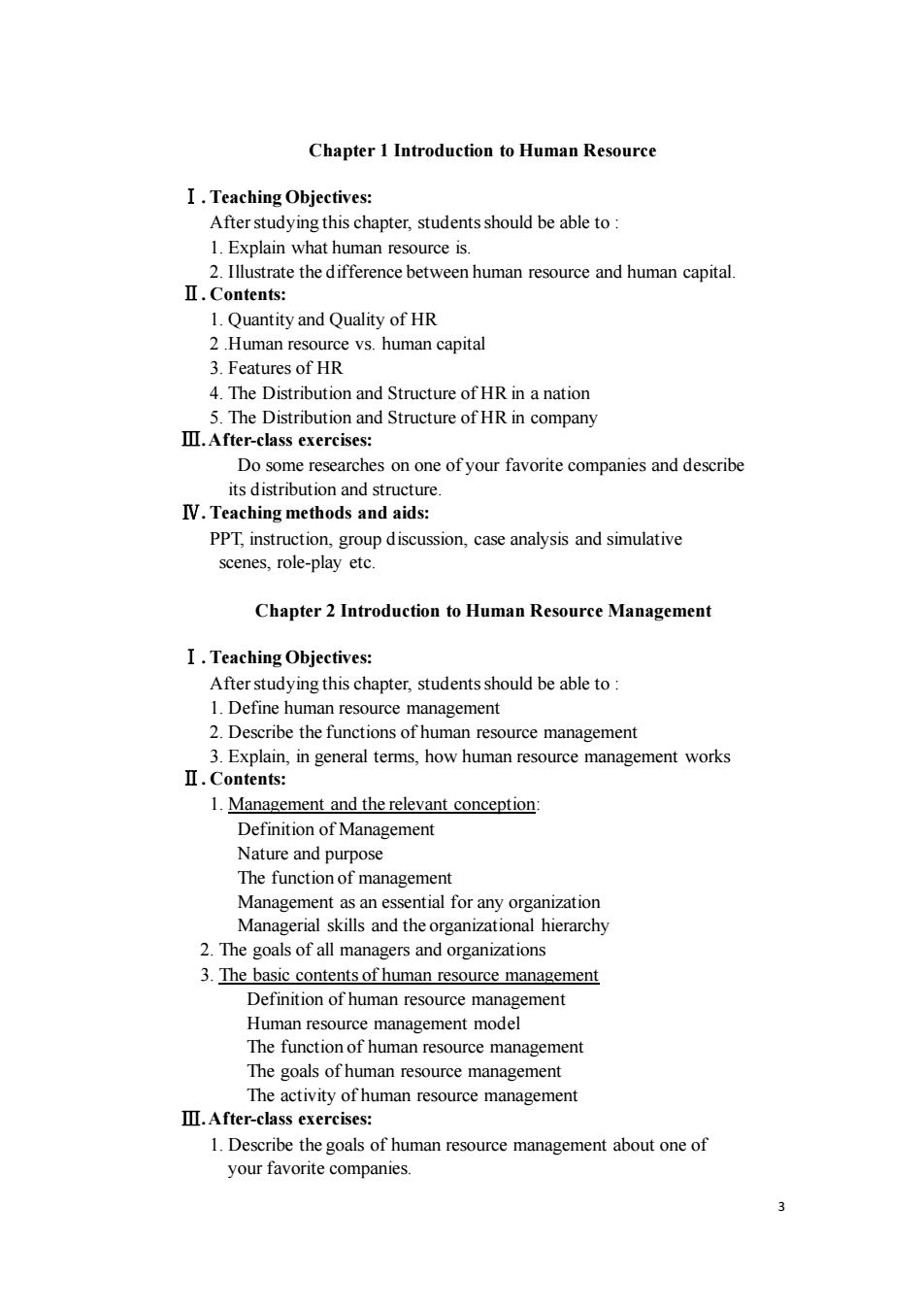
Chapter 1 Introduction to Human Resourc I.Teaching Objectives: After studying this chapter,students should be able to: 1.Explain what human resource is. rate the difference between human resource and human capital .Contents: 1.Quantity and Quality of HR 2.Human resource vs.human capital 3.Features of HR 4.The Distribution and Structure of HR in a nation 血.dnco Do some researches on one of your favorite companies and describe its distribution and structure IV.Teaching methods and aids: PPT inst ction. g oup discussion,case analysis and simulativ scenes,role-play ete Chapter 2 Introduction to Human Resource Management I.Teaching Objectives: After studying this chapter,students should be able to I.Define human resource management 2.Describe the functions of human resource management 3.Explain,in general terms,how human resource management works II.Contents: Definition of Management Nature and purpose The function of management Managerial skills and the organizat .The goalsof ll 3.The basic contents of human resource management Definition of human resource management Human resource management model The function of human resource management The goals of human resource managemen The activity of human resource management .After-class exercises: 1.Describe the goals of human resource management about one of your favorite companies
3 Chapter 1 Introduction to Human Resource Ⅰ. Teaching Objectives: After studying this chapter, students should be able to : 1. Explain what human resource is. 2. Illustrate the difference between human resource and human capital. Ⅱ. Contents: 1. Quantity and Quality of HR 2 .Human resource vs. human capital 3. Features of HR 4. The Distribution and Structure of HR in a nation 5. The Distribution and Structure of HR in company Ⅲ.After-class exercises: Do some researches on one of your favorite companies and describe its distribution and structure. Ⅳ. Teaching methods and aids: PPT, instruction, group discussion, case analysis and simulative scenes, role-play etc. Chapter 2 Introduction to Human Resource Management Ⅰ. Teaching Objectives: After studying this chapter, students should be able to : 1. Define human resource management 2. Describe the functions of human resource management 3. Explain, in general terms, how human resource management works Ⅱ. Contents: 1. Management and the relevant conception: Definition of Management Nature and purpose The function of management Management as an essential for any organization Managerial skills and the organizational hierarchy 2. The goals of all managers and organizations 3. The basic contents of human resource management Definition of human resource management Human resource management model The function of human resource management The goals of human resource management The activity of human resource management Ⅲ.After-class exercises: 1. Describe the goals of human resource management about one of your favorite companies
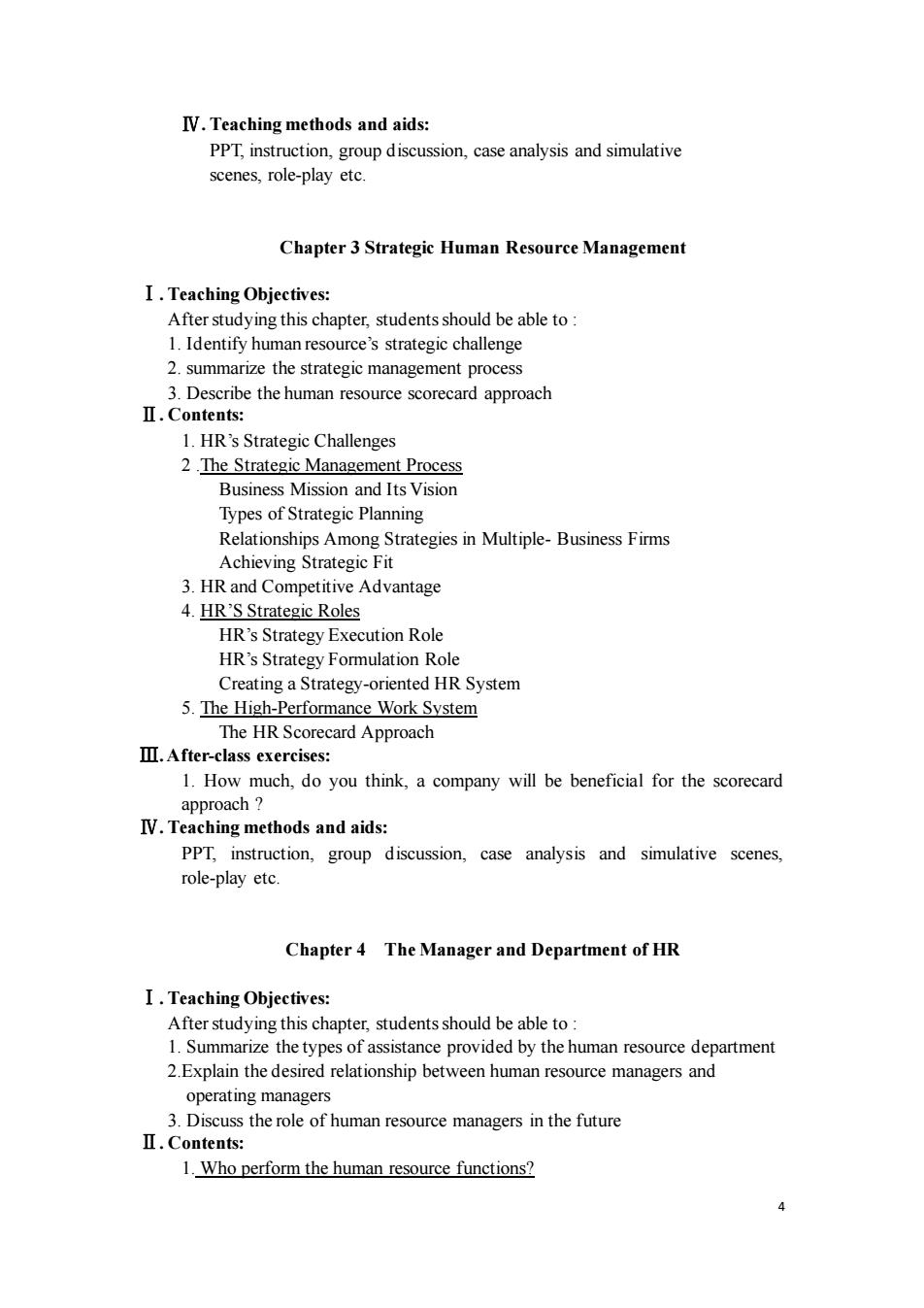
IV.Teaching methods and aids: PPT,instruction,group discussion,case analysis and simulative scenes,role-play etc Chapter 3 Strategic Human Resource Management I.Teaching Objectives After studying this chapter,students should be able to 1.Identify human resource's strategic challenge 2.summarize the strategic management process 3.Describe the humar e scorecard approach Ⅱ.Contents: 1.HR's Strategic Challenges 2 The Strategic Management Process Business Mission and Its Vision Achieving Strategic FI 3.HR and Competitive Advantage 4.HR'S Strategic Roles Hr's strategy execution role HR'sStra yFormulation Role Creating a Strategy-oriented HR System 5.The High-Performance Work System The HR Scorecard Approach II.After-class exercises: 1.How much,do you think,a company will be beneficial for the scorecard PPT,instruction,group discussion,case analysis and simulative scenes. role-play etc. Chapter 4 The Manager and Department of HR I.Teaching Objectives: After studying this chapter,students should be able to 1 Sum e provide d by the resource departmen 2Expla he dationship between humn fesource mangersand operating managers 3.Discuss the role of human resource managers in the future Ⅱ.Contents: 1.Who perform the human resource functions?
4 Ⅳ. Teaching methods and aids: PPT, instruction, group discussion, case analysis and simulative scenes, role-play etc. Chapter 3 Strategic Human Resource Management Ⅰ. Teaching Objectives: After studying this chapter, students should be able to : 1. Identify human resource’s strategic challenge 2. summarize the strategic management process 3. Describe the human resource scorecard approach Ⅱ. Contents: 1. HR’s Strategic Challenges 2 .The Strategic Management Process Business Mission and Its Vision Types of Strategic Planning Relationships Among Strategies in Multiple- Business Firms Achieving Strategic Fit 3. HR and Competitive Advantage 4. HR’S Strategic Roles HR’s Strategy Execution Role HR’s Strategy Formulation Role Creating a Strategy-oriented HR System 5. The High-Performance Work System The HR Scorecard Approach Ⅲ.After-class exercises: 1. How much, do you think, a company will be beneficial for the scorecard approach ? Ⅳ. Teaching methods and aids: PPT, instruction, group discussion, case analysis and simulative scenes, role-play etc. Chapter 4 The Manager and Department of HR Ⅰ. Teaching Objectives: After studying this chapter, students should be able to : 1. Summarize the types of assistance provided by the human resource department 2.Explain the desired relationship between human resource managers and operating managers 3. Discuss the role of human resource managers in the future Ⅱ. Contents: 1. Who perform the human resource functions?
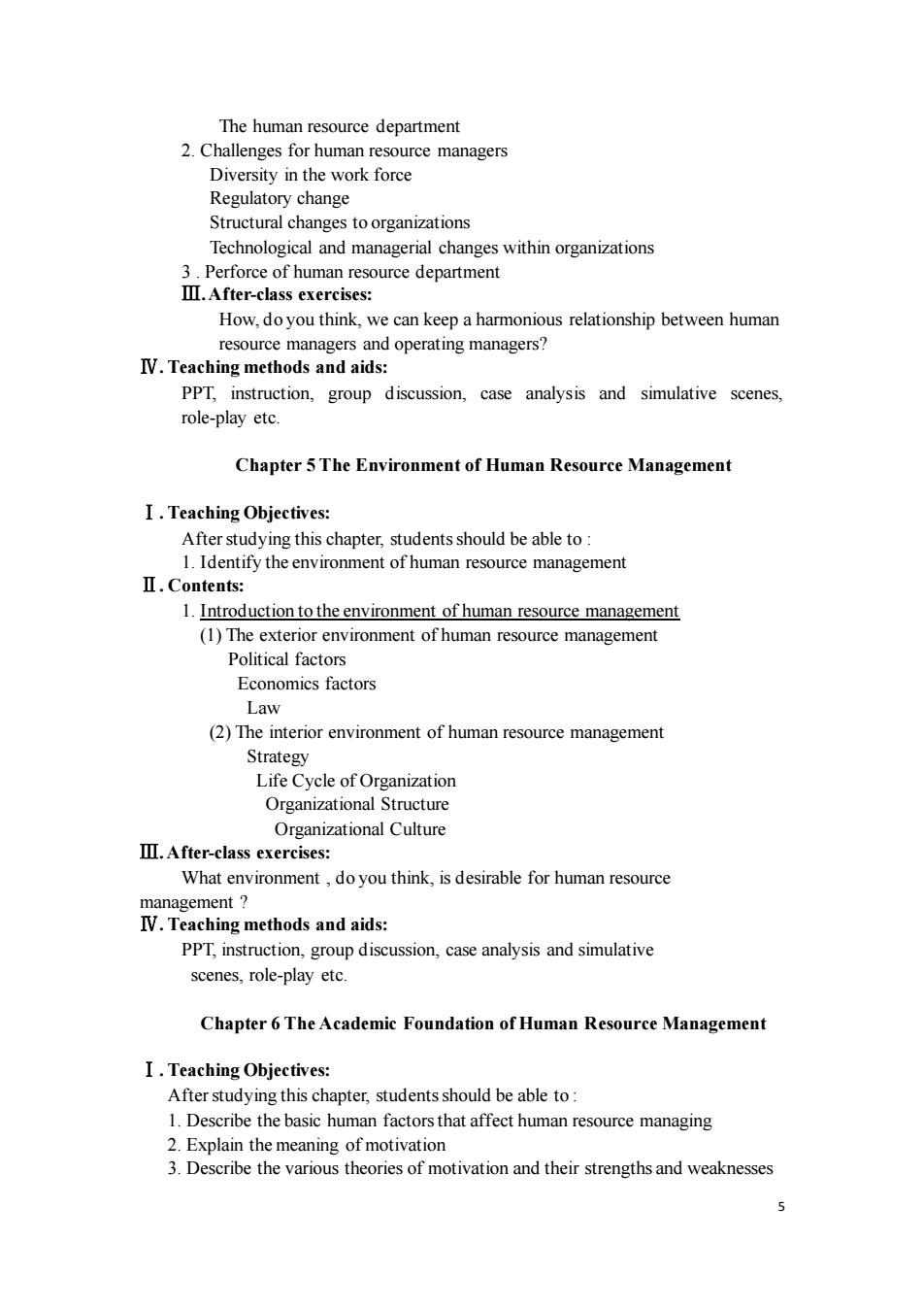
The human resource department 2.Challenges for huma resource managers Diversity in the work force Regulatory change Structural changes to organizations Technological and managerial changes within organizations 3.Perforce of huma urce departmer .A class exer How,do you think,we can keep a harmonious relationship between human resource managers and operating managers? IV.Teaching methods and aids: PPT,instruction,group discussion,case analysis and simulative scenes role-play etc. Chapter 5The Environment of Human Resource Management I.Teaching Objectives: After study 1.Ide Ⅱ.Contents: 1.Introduction to the environment of human resource management (1)The exterior environment of human resource management Political factors Economics factors Law (2)The interior environment of human resource management Strategy Life Cycle of Organization izational St Organizational Culture II.After-class exereises: What environment,do you think,is desirable for human resource management? IV.Teaching methods and aids: PPT instruction,analysis and simulativ scenes.role-play etc Chapter 6 The Academic Foundation of Human resource management I.Teaching Objectives After studying this chapter,students should be able to 1.Describe the basic human factors that affect human resource managing 2.Explain the meaning of motivation 3.Describe the various theories of motivation and their strengths and weaknesses
5 The human resource department 2. Challenges for human resource managers Diversity in the work force Regulatory change Structural changes to organizations Technological and managerial changes within organizations 3 . Perforce of human resource department Ⅲ.After-class exercises: How, do you think, we can keep a harmonious relationship between human resource managers and operating managers? Ⅳ. Teaching methods and aids: PPT, instruction, group discussion, case analysis and simulative scenes, role-play etc. Chapter 5 The Environment of Human Resource Management Ⅰ. Teaching Objectives: After studying this chapter, students should be able to : 1. Identify the environment of human resource management Ⅱ. Contents: 1. Introduction to the environment of human resource management (1) The exterior environment of human resource management Political factors Economics factors Law (2) The interior environment of human resource management Strategy Life Cycle of Organization Organizational Structure Organizational Culture Ⅲ.After-class exercises: What environment , do you think, is desirable for human resource management ? Ⅳ. Teaching methods and aids: PPT, instruction, group discussion, case analysis and simulative scenes, role-play etc. Chapter 6 The Academic Foundation of Human Resource Management Ⅰ. Teaching Objectives: After studying this chapter, students should be able to : 1. Describe the basic human factors that affect human resource managing 2. Explain the meaning of motivation 3. Describe the various theories of motivation and their strengths and weaknesses